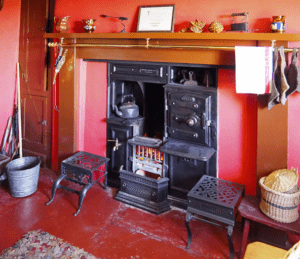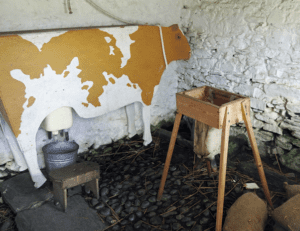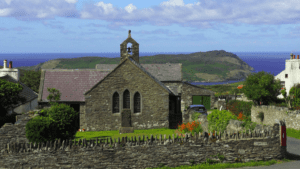Set on an upland pasture over looking the Sound and Calf of Man, Cregneash was a isolated settlement of small crofts each owning a few acres of land. It was a hard life dependent on fishing, subsistence agriculture, weaving and quarrying. Its very isolation at the tip of the Isle of Man meant the Manx language and the old way of life survived here well into the C20th.
Electricity didn’t arrive until 1938 and running water in the 1940s. Before then, the villagers were dependent on wells for water. The central well in the village was used for washing, with those on the outskirts being used for drinking water.
Cregneash was even promoted as a Victorian tourist attraction, with small thatched cottages surrounded by small fields.
Many families left the village during the C20th, Some cottages were left derelict, others were pulled down with their walls forming field boundaries. A few, like Crebbin’s Cottage were let out as holiday homes.
When Harry Kelly died in 1935, his family gifted his cottage to the Manx Museum and it was open to the public in 1938 as the first open air folk museum in Britain. Deemster Percy Cowley, who is recorded by a memorial overlooking the Sound, championed the need for a Manx National Trust and began to acquire land around Cregneash. The Karren farmstead was acquired a few years later, as an example of an unmodernised traditional Manx farmstead with farmhouse, stables and cowshed. Church Farm is an example of wealthy early C20th farm.
Now the Manx National Trust owns over 300 acres of land and ten buildings. There are still a few privately owned buildings but there are rigorous restrictions placed on what can be done with them.
“St Peter’s Church “:http://wasleys.org.uk/eleanor/man/churchesandcrosses/churches/churches_one/creagneash/index.html was built at the end of the C19th by the villagers to save them the long walk to the parish church three miles away. The church belongs to the Diocese and not Manx National Trust but is open during the summer months.
Buildings originally had turf walls with a thatch roof. Later walls were built of stone found in the fields or from outcrops on Meayll Hill, and held together with clay mortar. Walls were whitewashed. The slate for the lintels of the windows, doors and hearth came from quarries on Spanish Head.
Roofs were lined with turf cut from rough grassland and laid across the rafters with the soil side down, thus forming the base for the thatch.
There are no reeds on the island, so the villagers had to use straw left over from the harvest. Unlike modern varieties of wheat, this had very long stalks. The thatch was held in place by hand twisted ropes made of straw. These were anchored to small protruding stones in the walls called bwoid sugganes. Unlike the walls, these were never whitewashed as the lime could rot the straw rope. The thatch needed replenishing every three years.
Floors were made from compacted earth. Clay soil was mixed with lime or brick dust, crushed bones, blood, milk and manure to form a hard wearing surface. This never completely dries out, staying dust free and never cracks. However, rugs can’t be put on it.
The cottages were typically two rooms. Thie Mooar, or big room was open to the rafters, and had an open hearth.
The smaller room was used as a bedroom and had a loft above where the children slept. This was reached by a ladder and a fishing net was often hung across to stop young children falling off. Windows were small, so walls were whitewashed to reflect all available light.
Later some cottages were extended by adding an extra storey. In cottages like Crebbin’s Cottage, this was done by extending the loft across the full width of the cottage to form bedrooms which were reached by steep stairs up to a hatch. This allowed the downstairs bedroom to be used as a parlour.
Others like Church Farm, Cummel Beg (now the visitor centre) and Creg-y-Shee (now the cafe) were extended upwards with a second storey and new roof. The last two were also given larger windows and pebbledashed exterior giving the impression they are much later.
In the C20th, more modern houses were built along the main road above the village. Some still have the original cottages next to them.
The villagers were part time crofters growing a few crops (oats, barley and wheat along with potatoes and turnips) on small parcels of land. Fields were small, with hedges giving shelter from the winds and the only fertiliser was dung from the animals.
They may have had a cow for milk and kept a few hens and sheep. Many had a part share in a fishing boat and the men fished in the summer months leaving the work on the croft to the wives and children. Any spare milk, butter or eggs were sold at the local market. Turf for heating and cooking was cut on Meayll Hill and was a communal activity.
All farm work was done by hand although horses were used for ploughing and, again, these were shared in exchange for other work.
The crofters would have kept the traditional Loaghtan sheep as these were ideally suited to rough upland grazing. Their wool produced a very strong hard wearing cloth, but it had a short staple making it more difficult to spin. The Loaghtan fell out of favour and, by the start of the C19th, was being replaced by Scottish black face sheep as their fleece had a longer staple. Every house had spinning wheel. Wool was taken to Silverburn to be washed and carded and then came back to be woven by one of the five hand weavers in the village.
Meals were very simple and cooked over the open peat fire, either on a griddle or a large metal pot hanging from a chain in the chimney. The fire was kept burning all the time and it was regarded as bad luck to let it go out. Embers to start a new fire could be obtained from neighbours. Breakfast and the evening meal were usually porridge and a small bowl of porridge was left out overnight for the fairies. The mid day meal was either herring and potatoes or else a stew made from a bit of meat and lots of vegetables boiled up over the fire. Bonnag, an unleavened bread made from flour and buttermilk and cooked on the griddle, was a good filler.
This is a fascinating place to visit. Costumed interpreters are in “Harry Kelly’s Cottage”:http://wasleys.org.uk/eleanor/man/south/cregneash/cregneash_two/index.html and also “Church Farm”:http://wasleys.org.uk/eleanor/man/south/cregneash/cregneash_three/index.html and talk about what life was like. There are lots of stories to keep people of all ages entertained. There is a short walk around the fields with views across to the Sound. You may be lucky enough to see Loaghtan sheep and shire horses at work as well as hens around Church Farm. The cafe serves Bonnag which is very good.
There is a lot more information and pictures of Cregneash “here.”:http://wasleys.org.uk/eleanor/man/south/cregneash/index.html










